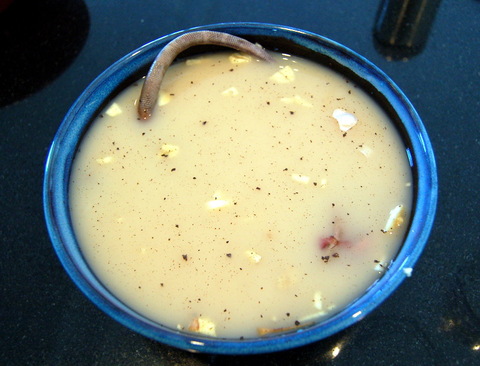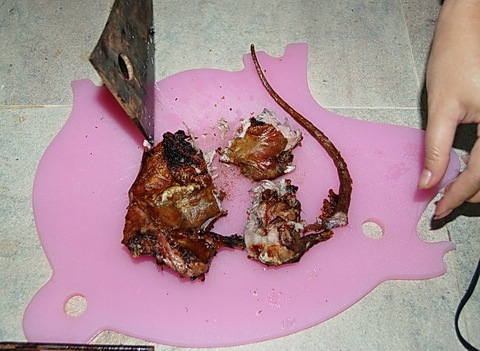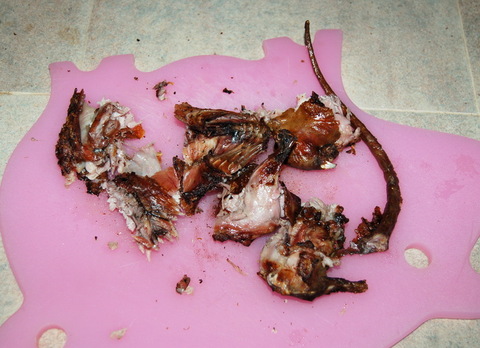There are rumors of an imminent coup in Bangkok again. It may happen, it may not. Our house and family is protected by sheer distance. The only reason I write about this at all is in case telecom service is interrupted; there’s really nothing to worry about.
Happy Thanksgiving!
Eating Mickey (or, how I overcame one of my last food prejudices)
I ask that you have an open mind about this post, because the conclusion may surprise you – it sure surprised me.
Here I am with my pal Mickey Rat:

Mickey was a gift from Max’s babysitter’s husband, who went hunting for the fat critters in the rice fields last Friday night. Mickey came dressed and with all fur removed, and upon first inspection seemed clean enough… Why then did the mere sight of Mickey’s long tail cause such feelings of repulsion and disgust in me? Therein lies the irony: Originally, we were to be given a much larger present, but it was determined that such a large specimen might turn us off to rodents all together (This was excellent foresight on the giver’s part.).
To sum things up, I fought through all the icky feelings and prejudices and decided on the spot that Mickey was going to roast on my trusty ghetto grill that very evening. I would call up some friends both to bolster my courage and share this important experience with someone. I had a plan, I had a rat… and I was going to eat it.

Ingredients for J’s Special Field Rat Marinade
- 1 tbsp. salt
- 1 tbsp. nampla (refined fish sauce)
- some ground black pepper
- 1/2 cup milk
- 30cc cheap whiskey
- whatever crusty remains you can sweep out of your herb drawer
- enough water to immerse rat
The milk is a trick I’ve seen used by grilled chicken vendors. I’d like to believe that there are enzymes in milk that help soften the meat, but the vendors just tell me they do it because that’s how they were taught by their friends. Unscientific bitches.
Anyway, I digress. Mickey was bound for the grill.

We (by that time friends had arrived) cooked the main course of the night quite slowly. First I seared both sides over the hot spots of the coals and then slow roasted 20 minutes to a side. The skin was quite fatty, like a suckling pig, and drips of juice caused merry flameups over the coals. It smelled… good. After the rat was halfway done, I also started grilling chicken wings which I had marinated in a same same but different kind of marinade. The idea was to use the chicken as a control, since basically everyone says everything takes like chicken.
So what does a fat, juicy field rat that’s eats rice almost exclusively (the people who hunt them know because they open their stomachs to see) taste like? Scroll down for our verdict:


.
.
.
.
.
.
.
.
.
.
.
.
.
.
.
.
.
.
.
.
.
.
.
.
.
IT WAS DELICIOUS.
I couldn’t believe how good it was… First of all, it was perfectly grilled, but you could perfectly grill a marinated penguin and it probably would not taste very good. This was choice meat.
Yes, I would eat it again.
Yes, it did have overtones of chicken. No, it wasn’t smelly or gamey or gross in any way. The marinade and slow cooking rendered the meat soft yet pleasantly textured. The skin was crispy and closest to a roast suckling pig, I think.
/////////////////////////////////
So the next time you encounter a story about how rat meat is coming into fashion in India again or how grilled rat outsells chicken in the Vietnam countryside, just remember: It may not just be because rat meat is cheap. It may very well be because it tastes good.
Exercising Atrophied Illustrator Muscles
Well it took a whole day, but I finished our nengajo (traditional Japanese New Years cards) design! Yay! Max helped out by drooling on my keyboard and now all we have to do is get them printed, handwrite addresses and short greetings (mommy’s job), and send them out in the post!
Since we changed addresses from last year we want to get the drop on everybody before they send cards to our old address… But to be quite honest, we have been bad analog correspondents – we haven’t sent cards since we left Japan (didn’t send very consistently then either, although we did the very last year we were there).
Time to take a nap with baby until midnight.
$25 and a Train Ticket
You may have heard by now about Google’s partnership with LIFE magazine: 10 million photos recently released, most of which have never been seen by the public. You can check out the site here: http://images.google.com/hosted/life
I started playing with it today and was really impressed. I think I’ll integrate it into an upcoming lesson for the computer class I’m teaching.
I don’t really know why, but I started out searching for one thing and got drawn down another path, and then another, and then I finally ended up looking for photos of internment camps – and WOW – there’s photos in here I’ve been looking for all my life it seems… they show a level of detail to the camps that I’ve often wondered about but never had the resources to look up. So I’d like to share some of the better ones I found, and they are very good – taken by the likes of Dorothea Lange, Hansel Mieth, and Carl Mydans. So without further ado:
- Posted notice informing people of Japanese ancestry of imminent relocation
- Japanese Americans registering for mandatory alien relocation
- Japanese-American girl waiting alone atop family baggage for bus to an assembly center
- Nisei Japanese-Americans participating in flag saluting ceremony at relocation center in forced internment during WWII in fear of “fifth-column” activity aiding Japanese enemy.
- Japanese-American soldiers on leave visiting their families
- Japanese reading in library at alien relocation camp.
- Interior of oriental style apartment at relocation camp.
- Young Japanese Nisei playing guitar in the stockade at Tule Lake Segregation Center
- Japanese Americans shopping in grocery store at the Heart Mountain Relocation Camp
- Japanese-American family working on their farm after returning from internment camps
Notes: Check out the caption on #6 (are they really Japanese?). Also, if you zoom in you can identify magazines. #7 is horribly staged but a great insight into what rooms could look like. I swear there’s a set of swords in the background (maybe bokken?). #9 Besides the box of Arm & Hammer and the Oxydol, I don’t recognize any of the product labels…
////////////////////////////////////////////
The title of this post refers to what the internees were offered when they finally got to go home.
I can’t believe there’s still idiots in this day and age that defend internment… Actually, maybe that’s one of the reasons this subject is still important.
Plagues and Pleasures on the Salton Sea
This is the best film I’ve seen in a long time:

Gladiatus link
Yes, I am aware that this is a huge waste of time, but D got me hooked on this free gladiator game, and although I’m busy with this and that, every spare minute is spent doing a Russel Crowe impersonation online. So, come join me, fellow wannabe Romans:
http://s5.gladiatus.com/game/c.php?uid=109056
D-cons need love too
Here’s a healthy dose of Voltron to balance out OP’s recent time in the limelight:
(seen at Boingboing)


